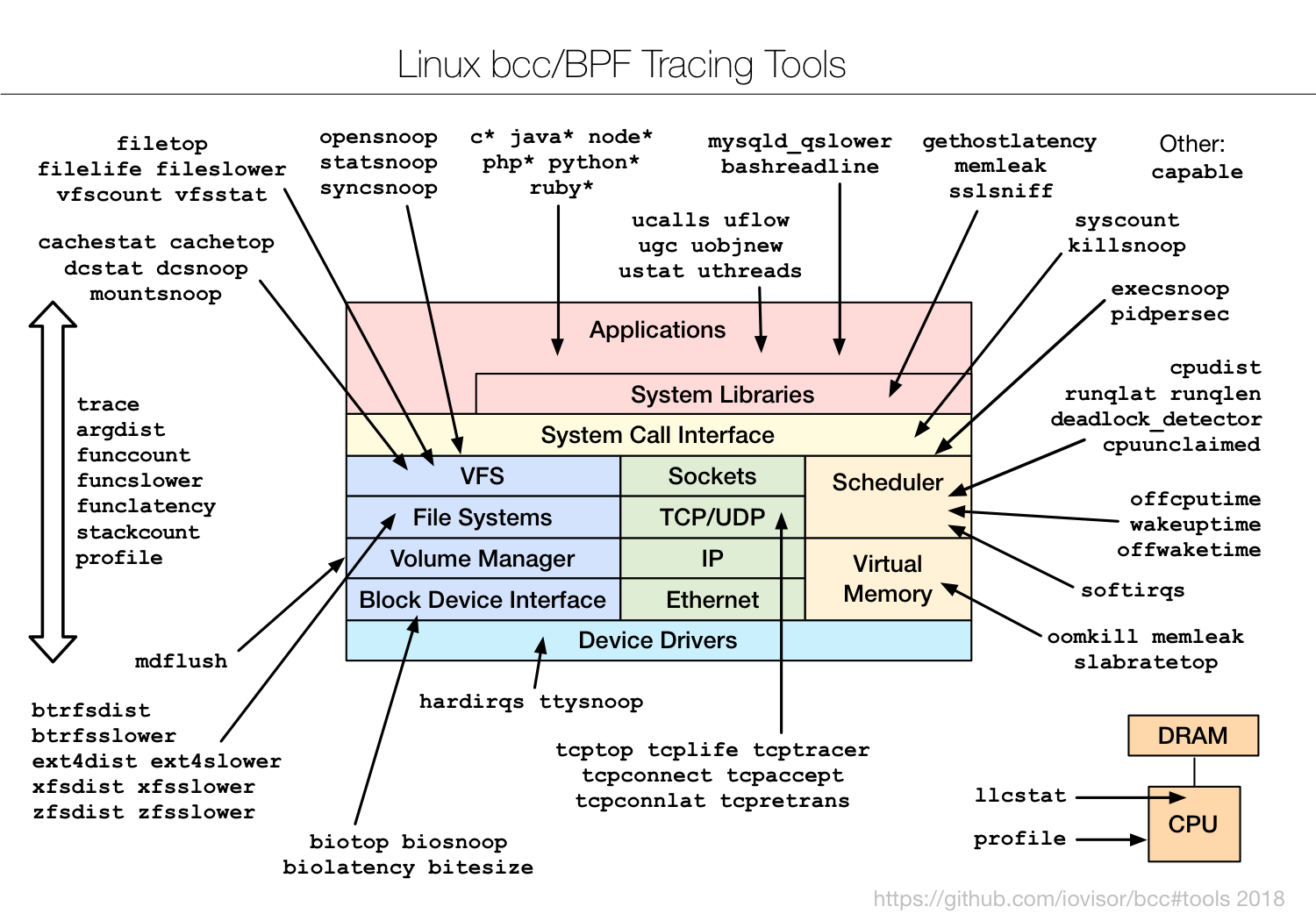For USENIX LISA 2016 I gave a talk that was years in the making, on Linux bcc/BPF analysis tools.
"Time to rethink the kernel" - Thomas Graf
Thomas has been using BPF to create new network and application security technologies (project Cilium), and build something that's starting to look like microservices in the kernel (video). I'm using it for advanced performance analysis tools that do tracing and profiling. Enhanced BPF might still be new, but it's already delivering new technologies, and making us rethink what we can do with the kernel.
My LISA 2016 talk begins with a 15 minute demo, showing the progression from ftrace, then perf_events, to BPF (due to the audio/video settings, this demo is a little hard to follow in the full video, but there's a separate recording of just the demo here: Linux tracing 15 min demo). Below is the full talk video (youtube):
Here are the slides or as a PDF:
Installing bcc/BPF
To try out BPF for performance analysis you'll need to be on a newer kernel: at least 4.4, preferably 4.9. The main front end is currently bcc (BPF compiler collection), and there are install instructions on github, which keep getting improved. For Ubuntu, installation is:
echo "deb [trusted=yes] https://repo.iovisor.org/apt/xenial xenial-nightly main" | sudo tee /etc/apt/sources.list.d/iovisor.list sudo apt-get update sudo apt-get install bcc-tools
There's currently a pull request to add snap instructions, as there are nightly builds for snappy as well.
Listing bcc/BPF Tools
This install will add various performance analysis and debugging tools to /usr/share/bcc/tools. Since some require a very recent kernel (4.6, 4.7, or 4.9), there's a subdirectory, /usr/share/bcc/tools/old, which has some older versions of the same tools that work on Linux 4.4 (albeit with some caveats).
# ls /usr/share/bcc/tools argdist cpudist filetop offcputime solisten tcptop vfsstat bashreadline cpuunclaimed funccount offwaketime sslsniff tplist wakeuptime biolatency dcsnoop funclatency old stackcount trace xfsdist biosnoop dcstat gethostlatency oomkill stacksnoop ttysnoop xfsslower biotop deadlock_detector hardirqs opensnoop statsnoop ucalls zfsdist bitesize doc killsnoop pidpersec syncsnoop uflow zfsslower btrfsdist execsnoop llcstat profile tcpaccept ugc btrfsslower ext4dist mdflush runqlat tcpconnect uobjnew cachestat ext4slower memleak runqlen tcpconnlat ustat cachetop filelife mountsnoop slabratetop tcplife uthreads capable fileslower mysqld_qslower softirqs tcpretrans vfscount
Just by listing the tools, you might spot something you want to start with (ext4*, tcp*, etc). Or you can browse the following diagram:

Using bcc/BPF
If you don't have a good starting point, in the bcc Tutorial I included a generic checklist of the first ten tools to try. I also included this in my LISA talk:
- execsnoop
- opensnoop
- ext4slower (or btrfs*, xfs*, zfs*)
- biolatency
- biosnoop
- cachestat
- tcpconnect
- tcpaccept
- tcpretrans
- runqlat
- profile
Most of these have usage messages, and are easy to use. They'll need to be run as root. For example, execsnoop to trace new processes:
# /usr/share/bcc/tools/execsnoop PCOMM PID PPID RET ARGS grep 69460 69458 0 /bin/grep -q g2. grep 69462 69458 0 /bin/grep -q p2. ps 69464 58610 0 /bin/ps -p 308 ps 69465 100871 0 /bin/ps -p 301 sleep 69466 58610 0 /bin/sleep 1 sleep 69467 100871 0 /bin/sleep 1 run 69468 5160 0 ./run [...]
And biolatency to record an in-kernel histogram of disk I/O latency:
# /usr/share/bcc/tools/biolatency
Tracing block device I/O... Hit Ctrl-C to end.
^C
usecs : count distribution
0 -> 1 : 0 | |
2 -> 3 : 0 | |
4 -> 7 : 0 | |
8 -> 15 : 0 | |
16 -> 31 : 0 | |
32 -> 63 : 0 | |
64 -> 127 : 0 | |
128 -> 255 : 0 | |
256 -> 511 : 64 |********** |
512 -> 1023 : 248 |****************************************|
1024 -> 2047 : 29 |**** |
2048 -> 4095 : 18 |** |
4096 -> 8191 : 42 |****** |
8192 -> 16383 : 20 |*** |
16384 -> 32767 : 3 | |
Here's its USAGE message:
# /usr/share/bcc/tools/biolatency -h
usage: biolatency [-h] [-T] [-Q] [-m] [-D] [interval] [count]
Summarize block device I/O latency as a histogram
positional arguments:
interval output interval, in seconds
count number of outputs
optional arguments:
-h, --help show this help message and exit
-T, --timestamp include timestamp on output
-Q, --queued include OS queued time in I/O time
-m, --milliseconds millisecond histogram
-D, --disks print a histogram per disk device
examples:
./biolatency # summarize block I/O latency as a histogram
./biolatency 1 10 # print 1 second summaries, 10 times
./biolatency -mT 1 # 1s summaries, milliseconds, and timestamps
./biolatency -Q # include OS queued time in I/O time
./biolatency -D # show each disk device separately
In /usr/share/bcc/tools/docs or the tools subdirectory on github, you'll find _example.txt files for every tool which have screenshots and discussion. Check them out! There are also man pages under man/man8.
For more information, please watch my LISA talk at the top of this post when you get a chance, where I explain Linux tracing, BPF, bcc, and tour various tools.
What's Next?
My prior talk at LISA 2014 was New Tools and Old Secrets (perf-tools), where I showed similar performance analysis tools using ftrace, an older tracing framework in Linux. I'm still using ftrace, not just for older kernels, but for times where it's more efficient (eg, kernel function counting using the funccount tool). BPF is programmatic, and can do things that ftrace can't.
Doing ftrace at LISA 2014, then BPF at LISA 2016, you might wonder I'll propose for LISA 2018. We'll see. I could be covering a higher-level BPF front-end (eg, ply, if it gets finished), or a BPF GUI (eg, via Netflix Vector), or I could be focused on something else entirely. Tracing was my priority when Linux lacked various capabilities, but now that's done, there are other important technologies to work on...


Click here for Disqus comments (ad supported).